Contemporary glass art offers a unique blend of creativity and craftsmanship, showcasing innovative techniques like blowing, casting, and fusing. This versatile medium finds applications in architecture, fashion, and interior design, enhancing both aesthetics and functionality. Artists explore cultural narratives through themes of identity and sustainability, reflecting societal issues while pushing artistic boundaries. Additionally, emerging techniques like flame-working and cold working invite collaboration and experimentation, enriching the glass art landscape.
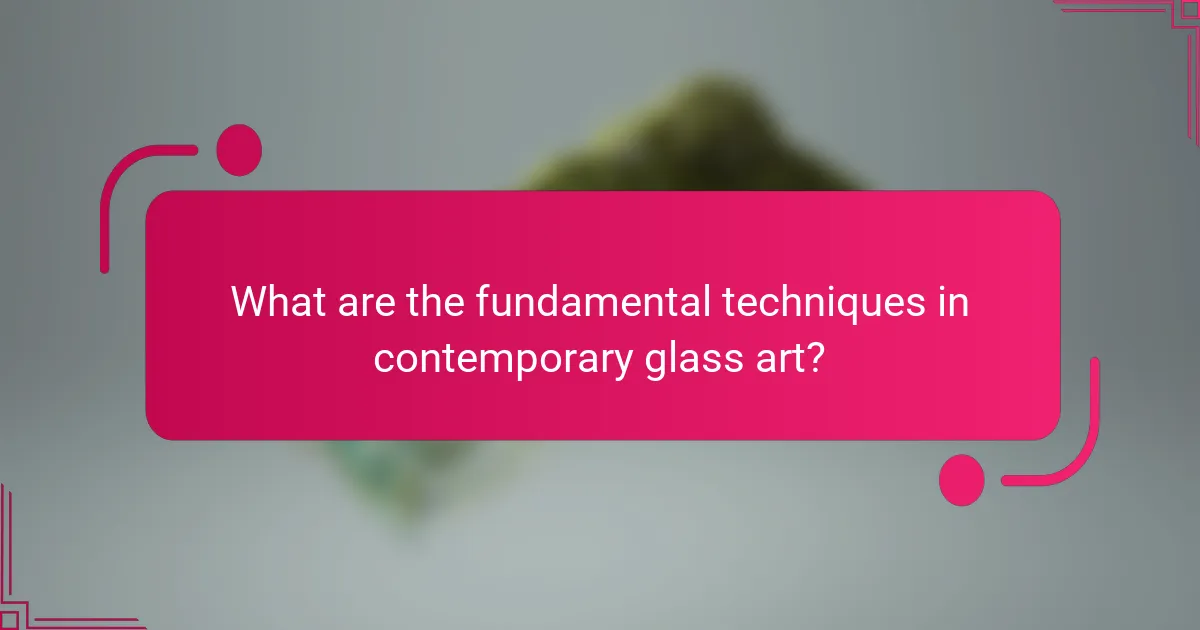
What are the fundamental techniques in contemporary glass art?
Contemporary glass art employs various techniques that define its innovative expressions. Key techniques include blowing, casting, fusing, and engraving.
Blowing involves shaping molten glass using a blowpipe, allowing for intricate designs. Casting entails pouring glass into molds, creating solid forms with detailed textures. Fusing combines glass pieces in a kiln to achieve layered effects. Engraving carves patterns into glass surfaces, enhancing visual depth.
These techniques reflect the unique attributes of contemporary glass art, emphasizing creativity and craftsmanship. Each method contributes to the cultural narratives surrounding this dynamic medium.
How does glassblowing influence artistic expression?
Glassblowing profoundly influences artistic expression by merging traditional techniques with contemporary themes. The fluidity of molten glass allows artists to explore unique forms and intricate designs. This medium encourages experimentation, leading to innovative works that reflect cultural narratives. Artists often use glass to convey personal stories, social issues, or environmental concerns, enhancing the emotional depth of their creations. The tactile nature of glass also invites viewer interaction, fostering a deeper connection between the artwork and its audience.
What role does kiln casting play in modern creations?
Kiln casting plays a crucial role in contemporary glass art by enabling intricate designs and textures. This technique allows artists to create unique forms by melting glass in a controlled environment, resulting in stunning visual effects. The precision of kiln casting enhances the artistic expression, making it a favored method for modern creators. Additionally, it supports the exploration of cultural narratives through glass, reflecting diverse artistic intentions and innovations.
Which innovative methods are emerging in glass art?
Innovative methods in glass art include 3D printing, kiln casting, and glassblowing with integrated technology. These techniques enhance creativity and functionality. For instance, 3D printing allows for intricate designs that traditional methods cannot achieve. Kiln casting offers unique textures and forms, while technology integration, such as augmented reality, enriches viewer interaction with glass pieces.
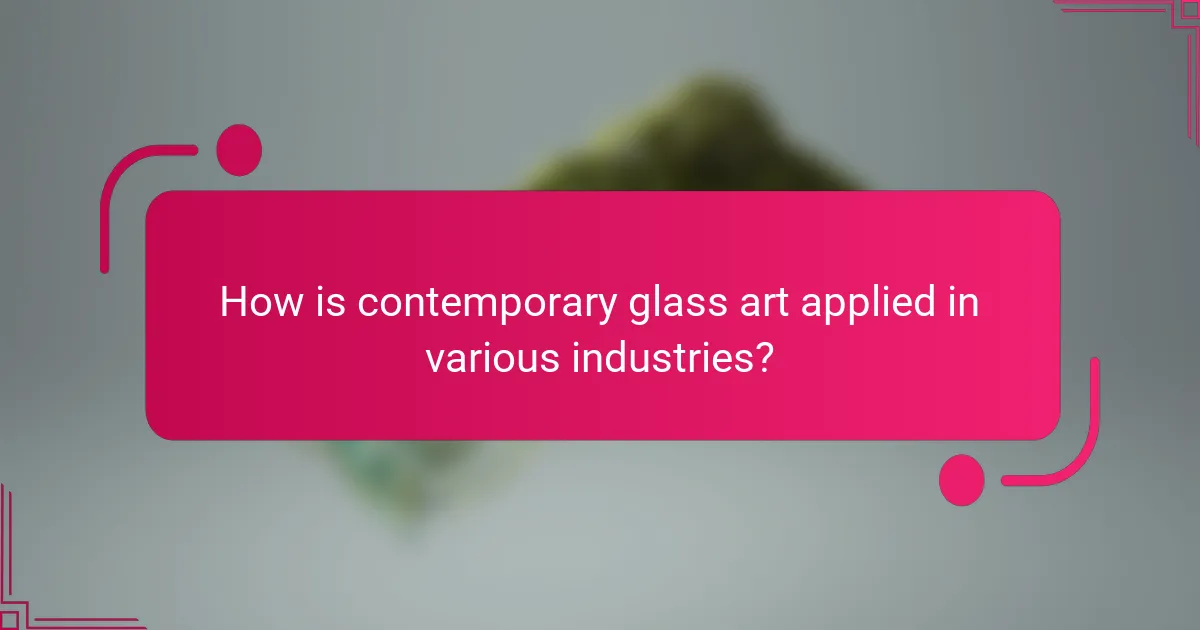
How is contemporary glass art applied in various industries?
Contemporary glass art is applied in various industries such as architecture, fashion, and interior design. In architecture, glass art enhances aesthetic appeal and functionality. Fashion designers incorporate glass elements to create unique accessories. Interior design utilizes glass art for decorative pieces, providing elegance and sophistication. Additionally, the art form is used in the automotive industry for innovative designs and features. The versatility of glass art allows for creative expression across these sectors.
What are the uses of glass art in interior design?
Contemporary glass art enhances interior design through unique aesthetics, functionality, and cultural storytelling. It serves as focal points, adds texture, and reflects light, creating dynamic spaces. Techniques like blowing, casting, and slumping offer diverse applications, from sculptures to functional items. Unique attributes, such as custom designs, allow for personalization in any environment. As a result, glass art not only beautifies but also enriches the narrative of interior spaces.
How is glass art integrated into public installations?
Glass art is integrated into public installations through various techniques and applications that enhance community spaces. Artists use methods like blowing, casting, and fusing to create unique pieces that reflect local culture and history. These installations often serve as focal points, engaging the public and encouraging interaction.
Public glass art can transform urban environments, adding color and light while promoting artistic expression. Unique attributes, such as site-specific designs, allow artists to tailor their work to the surrounding architecture and landscape. As a result, glass installations contribute to the cultural narrative of a community, fostering a sense of identity and pride.
The collaboration between artists, architects, and city planners is crucial for successful integration. This teamwork ensures that glass art complements existing structures and enhances the overall aesthetic. Public installations often include educational elements, informing viewers about the techniques and stories behind the artwork.
In summary, contemporary glass art enriches public spaces by combining innovative techniques with cultural narratives, creating visually stunning and meaningful installations that resonate with communities.
What role does glass art play in fashion and accessories?
Glass art significantly enhances fashion and accessories through unique designs and craftsmanship. Contemporary glass artists use innovative techniques to create wearable art pieces, such as jewelry and embellishments. These pieces often serve as statements of individuality and creativity, reflecting cultural narratives. The integration of glass in fashion allows for a fusion of traditional artistry with modern aesthetics, making it a sought-after choice for designers and consumers alike.
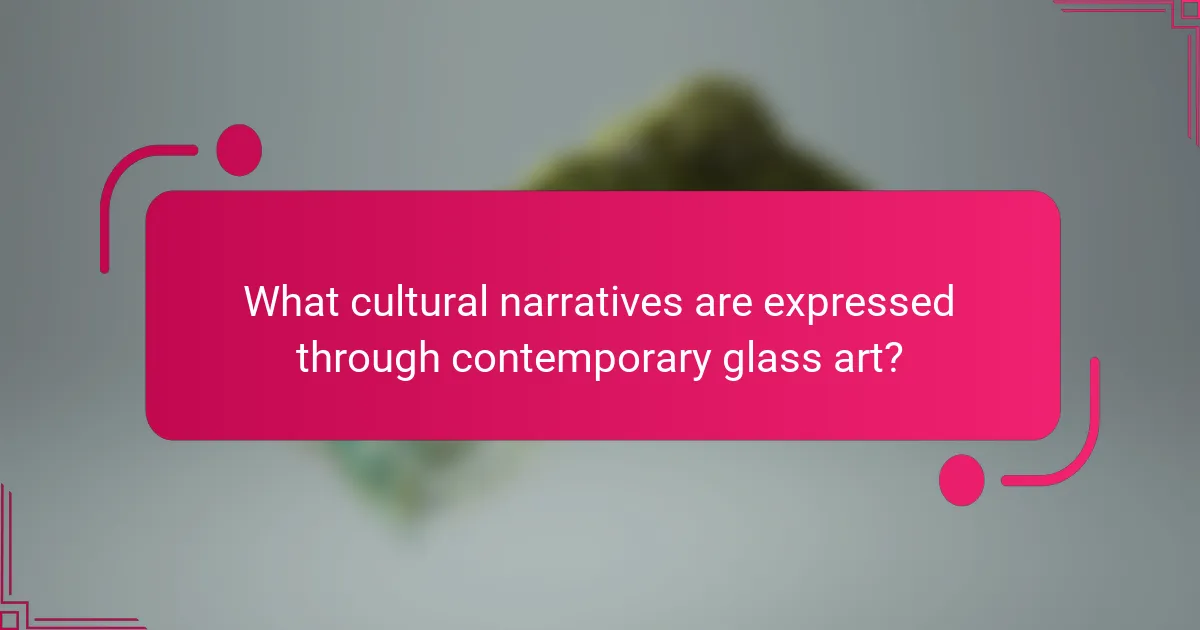
What cultural narratives are expressed through contemporary glass art?
Contemporary glass art expresses cultural narratives through themes of identity, transformation, and environmental awareness. Artists utilize techniques like blowing, casting, and fusing to create works that reflect societal issues. For example, glass sculptures can symbolize fragility, representing personal and collective experiences. Additionally, the use of recycled materials in glass art highlights sustainability, addressing contemporary environmental concerns. This medium serves as a powerful vehicle for storytelling, blending aesthetics with meaningful commentary on modern life.
How does glass art reflect societal values and issues?
Contemporary glass art reflects societal values and issues by addressing themes such as identity, environment, and social justice. Artists often use glass as a medium to challenge perceptions and provoke dialogue. For instance, the fragility of glass symbolizes vulnerability in social issues, while techniques like recycling glass highlight environmental concerns. This medium serves as a canvas for cultural narratives that resonate with current events and collective experiences. Through innovative applications, glass art becomes a mirror of society’s evolving values.
Which artists are redefining cultural narratives through glass?
Artists redefining cultural narratives through glass include artists like Dale Chihuly, who uses large-scale installations to explore themes of nature and light. Another notable figure is Judith Schaechter, known for her stained glass works that address social issues and personal narratives. These artists challenge traditional perceptions of glass as merely a decorative medium, transforming it into a powerful vehicle for storytelling and cultural commentary. Their innovative techniques and thematic depth highlight glass art’s potential to provoke thought and inspire dialogue.
What stories do glass art pieces tell across different cultures?
Contemporary glass art pieces convey rich cultural narratives that reflect diverse traditions and values. Each piece often symbolizes specific historical events, spiritual beliefs, or social practices unique to its culture. For example, Venetian glass art showcases intricate craftsmanship and trade history, while Indigenous glass art may express connection to nature and ancestral stories. Techniques like blowing and casting further enhance the storytelling aspect, allowing artists to imbue their works with personal and collective meaning. Cultural narratives in glass art continue to evolve, illustrating the dynamic interplay between tradition and modernity.
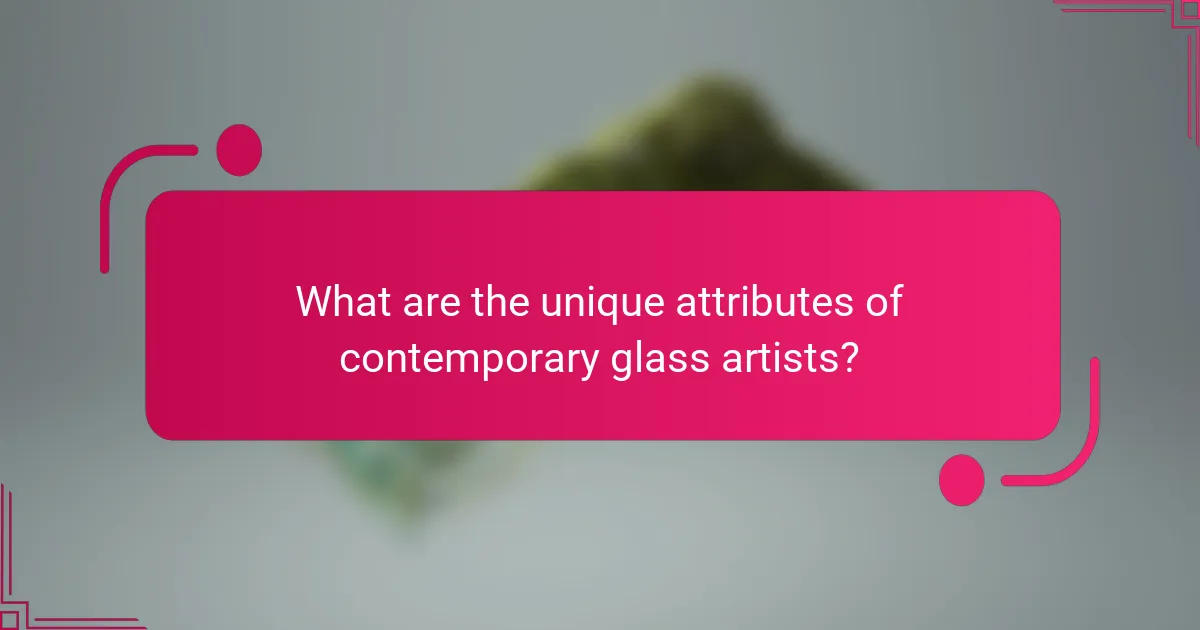
What are the unique attributes of contemporary glass artists?
Contemporary glass artists possess unique attributes that distinguish their work. They often blend traditional techniques with innovative approaches, such as using mixed media and digital technology. Their art frequently explores themes of identity, nature, and social commentary, reflecting cultural narratives. Additionally, many contemporary glass artists prioritize sustainability by sourcing eco-friendly materials and practices. This commitment enhances their artistic expression and resonates with modern audiences.
How do personal backgrounds influence artistic style?
Personal backgrounds significantly shape artistic style by influencing themes, techniques, and cultural narratives in contemporary glass art. Artists draw from their experiences, heritage, and environment, which inform their creative choices. For example, an artist from a coastal region may incorporate marine motifs, while urban artists might focus on industrial aesthetics. Cultural narratives often reflect societal issues, personal stories, and historical contexts, enriching the art form. This interplay of background and artistic expression creates a diverse landscape in contemporary glass art.
What distinguishes emerging artists from established names in glass art?
Emerging artists in glass art often focus on innovative techniques and personal narratives, while established names emphasize mastery and historical significance. Emerging artists typically experiment with unconventional materials and forms, showcasing fresh perspectives. Established artists have a recognized style and often command higher market value due to their reputation. Emerging artists may have limited exhibition history, whereas established names have a robust portfolio of exhibitions and accolades. This distinction shapes their visibility and influence within the contemporary glass art scene.
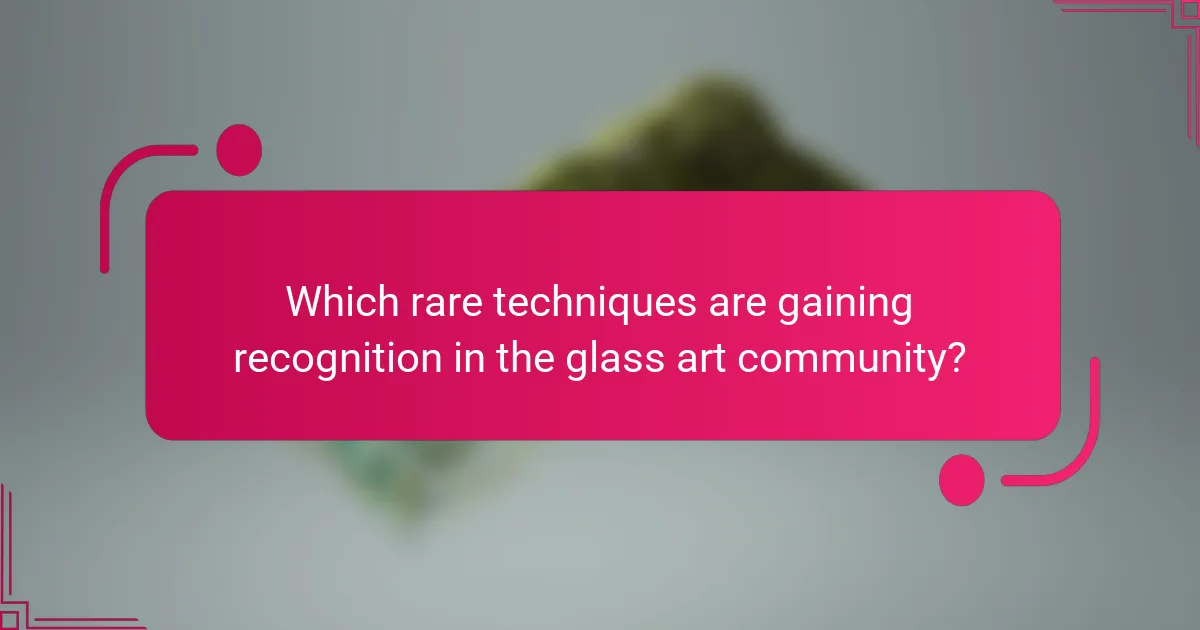
Which rare techniques are gaining recognition in the glass art community?
Innovative techniques like glass casting, flame-working, and cold working are gaining recognition in the glass art community. These methods allow artists to explore new forms and textures, enhancing the artistic expression of glassworks.
Glass casting involves pouring molten glass into molds, creating intricate shapes. Flame-working uses a torch to melt glass rods, allowing for detailed, small-scale designs. Cold working encompasses techniques like grinding and polishing, which refine the final appearance of glass pieces.
These rare techniques not only push the boundaries of traditional glass art but also invite collaboration across various artistic disciplines, enriching the cultural narratives surrounding contemporary glass art.
What are the challenges of using mixed media with glass?
Using mixed media with glass presents challenges like compatibility, durability, and aesthetic cohesion. Different materials may react differently to heat, light, or moisture, affecting the integrity of the artwork. Additionally, achieving a seamless visual integration can be difficult, as contrasting textures and colors may clash. The unique properties of glass, such as its transparency and fragility, further complicate the incorporation of other media.
How do rare materials enhance the value of glass art pieces?
Rare materials significantly enhance the value of glass art pieces by providing unique visual effects and increased durability. Incorporating elements like gold, silver, and precious stones adds distinctiveness and elevates the aesthetic appeal. These materials can create vibrant colors, intricate patterns, and textures that cannot be achieved with standard glass. As a result, collectors and art enthusiasts often seek pieces featuring rare materials, driving up their market value. The rarity of these materials also contributes to the overall narrative and craftsmanship associated with each artwork, making them more desirable in contemporary glass art.
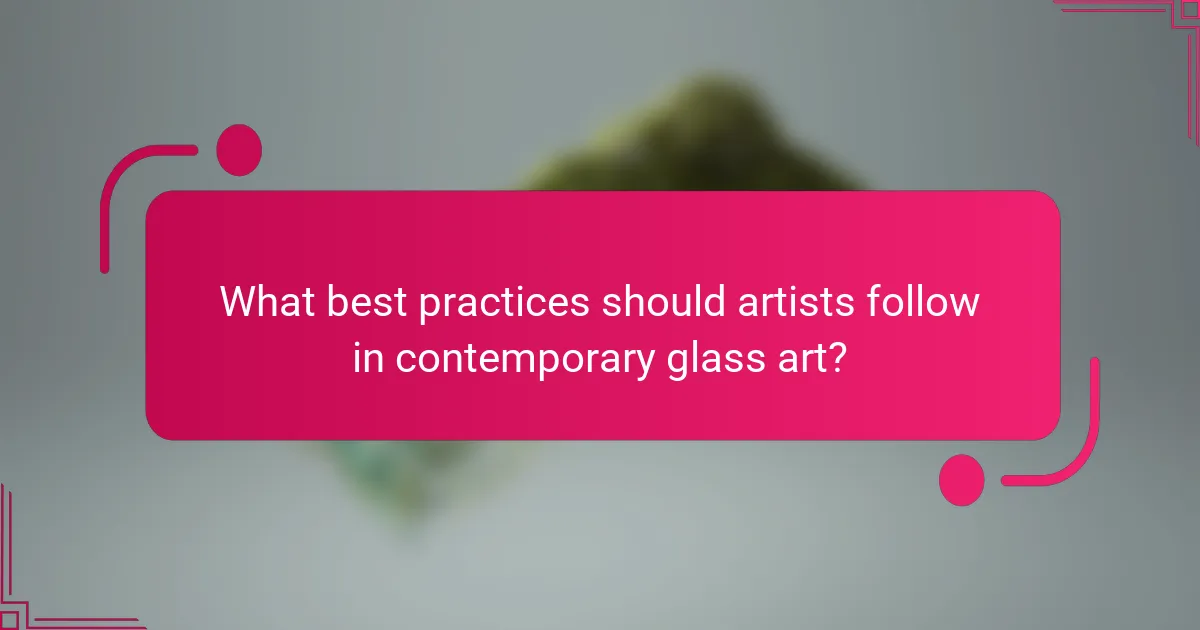
What best practices should artists follow in contemporary glass art?
Artists in contemporary glass art should prioritize experimentation, technical mastery, and storytelling. Engaging with diverse techniques enhances creativity and innovation. Understanding the properties of glass, such as its malleability and light interaction, is essential for effective application. Collaborating with other artists and disciplines can lead to unique cultural narratives, enriching the artwork’s context. Emphasizing sustainability in materials and processes reflects contemporary values, appealing to environmentally conscious audiences. Finally, actively participating in exhibitions and art communities fosters connections and visibility in the art world.
How can artists effectively market their glass art?
Artists can effectively market their glass art by leveraging social media, participating in exhibitions, and building a strong brand narrative. Social media platforms like Instagram showcase visual art, allowing artists to reach a wider audience. Exhibitions provide opportunities for direct engagement with potential buyers and collectors. A compelling brand narrative enhances emotional connections, making the art more relatable and desirable. Collaborations with interior designers can also expand market reach, as glass art becomes a sought-after element in modern decor.
What common mistakes should be avoided in glass art creation?
Avoiding common mistakes in glass art creation enhances both technique and final results. Key errors include neglecting safety measures, underestimating the importance of temperature control, and failing to plan designs thoroughly. Additionally, using inappropriate materials can compromise the integrity of the work. Lastly, overlooking the significance of proper tools and maintenance can lead to subpar craftsmanship.
Which resources are essential for aspiring glass artists?
Aspiring glass artists need essential resources to develop their skills and knowledge. Key resources include specialized tools, educational materials, and community support.
1. Glassblowing tools: These include blowpipes, punty rods, and shears, crucial for shaping glass.
2. Safety equipment: Protective eyewear, gloves, and aprons ensure safety during glass manipulation.
3. Instructional books: Texts on techniques and history provide foundational knowledge and inspiration.
4. Online tutorials: Video resources offer visual guidance on various methods and styles.
5. Workshops and classes: Hands-on experience from professionals enhances practical skills.
6. Community groups: Joining local or online artist communities fosters collaboration and feedback.
